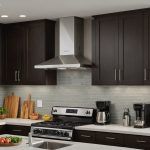Understanding Kitchen Island Lighting
Kitchen island lighting plays a critical role in both the functionality and aesthetic appeal of the space. Selecting the right lighting types is essential as it not only impacts the ambiance but also enhances usability. Among the popular choices are pendant lights, recessed lighting, and LED options.
Overview of Common Lighting Types for Kitchen Islands
- Pendant Lights: These add an elegant touch and can be adjusted to optimal heights for both style and efficiency.
- Recessed Lighting: Perfect for smaller spaces where overhead obstructions can be minimized, offering a streamlined look.
- LED Options: Known for their energy efficiency and versatility, LEDs provide a range of colour temperatures to suit different moods.
Importance of Style and Functionality
While style makes a statement, functionality ensures that the lighting meets everyday needs. For instance, pendant lights are ideal for focused areas but may require additional light sources for complete coverage.
Additional reading : Discover the Benefits of Copper Cookware for Your UK Kitchen: An Essential Guide!
Influence on Kitchen Ambiance and Usability
Lighting can transform a kitchen’s atmosphere, turning it from a mundane task area into a welcoming gathering space. Appropriate selection of kitchen island lighting ensures that the illumination is not only practical but also complements the kitchen’s overall interior design.
Key Factors to Consider for UK Homes
Kitchen island lighting in the UK involves specific considerations due to UK kitchen lighting standards and electrical regulations. UK regulations require that all electrical work complies with standards like the IET Wiring Regulations, ensuring safety and proper installation. Properly understanding these standards is crucial to avoid fines or hazards.
In parallel : Essential & Long-Lasting Fabrics for Kitchen Aprons: A Comprehensive UK Cook’s Handbook
When planning your lighting, consider your kitchen’s ceiling height and layout. Lower ceilings may benefit from recessed lighting to minimize visual obstruction, while higher ceilings allow for creative use of pendant lights. The layout and size of your kitchen can dictate the amount and type of lighting you’ll need for balanced illumination.
Local preferences in the UK often lean towards practical yet stylish solutions, combining aesthetics with functionality. Common lighting styles in UK homes include minimalist pendant lights and energy-efficient LEDs, which not only save on electricity bills but also contribute to a modern, uncluttered look.
Choosing lighting that aligns with both regulatory compliance and personal taste is important. Explore a mix of lighting types like pendant and recessed lights to match your kitchen’s interior design while ensuring they meet UK standards. Getting it right can significantly enhance both the ambiance and usability of your kitchen space.
Popular Types of Lighting for Kitchen Islands
When choosing lighting for kitchen islands, understanding the nuances of pendant lights, recessed lighting, and LED options can guide your decisions effectively.
Pendant Lighting
Pendant lighting offers diverse styles and materials, from rustic metals to elegant glass. The recommended height for pendant lights is typically 28 to 34 inches above your island surface to ensure proper illumination without obstructing views. The flexibility in placement allows for focused task lighting or ambient lighting. While they provide a stylish look, it’s essential to consider potential shadowing and the need for additional lighting sources.
Recessed Lighting
Ideal for both small and large kitchens, recessed lighting provides a sleek look, emphasizing space efficiency. When installing recessed lights, spacing them evenly across the ceiling ensures comprehensive coverage without leaving dark corners. Paying attention to beam angles and the lighting intensity is crucial for achieving the desired ambience without overwhelming the area.
LED Lighting
The appeal of LED lighting lies in its energy efficiency and cost savings over time. Available in various colour temperatures, LEDs can influence the kitchen’s mood; warmer tones create a cosy environment, while cooler tones offer a modern feel. Their versatility allows for creative installations, enhancing both practicality and design flexibility.
Aesthetic and Functional Design Tips
Coordinating kitchen design with the right lighting is essential in balancing aesthetic appeal and functionality. A well-thought-out lighting scheme can highlight your kitchen’s features while ensuring operational efficiency. When harmonizing lighting with design, consider the overall theme and colour palette of your space. Choose lighting fixtures that complement your kitchen’s style, whether contemporary or rustic, to create a unified look.
Balancing aesthetics with functionality involves more than just visual appeal. Functional lighting ensures that tasks are efficiently illuminated while adding a decorative touch. For instance, combining pendant lights with recessed options can provide layered lighting that accommodates various kitchen activities.
Incorporating dimmers adds versatility, allowing for mood adjustments based on different times and activities. Smart lighting solutions offer advanced control with settings that adapt to your lifestyle. This technology enhances the flexibility of lighting environments by providing convenience through automated or remote operation.
Practical use of lighting coordination ensures that fixtures not only elevate your kitchen’s interior design but also address everyday needs. By integrating design elements, lighting choices can significantly contribute to both the visual and practical aspects of your kitchen.
Installation Advice for Kitchen Island Lighting
Deciding between DIY installation and hiring a professional is crucial when it comes to kitchen island lighting. If you’re considering a DIY approach, ensure you have the necessary skills and adhere to safety standards. Essential tools include a voltage tester, wire stripper, and a sturdy ladder. Follow instructions meticulously to minimise risks, ensuring all connections are secure and safely grounded.
For those less confident in their electrical skills, hiring a certified electrician is wise, as they guarantee compliance with all regulations and standards. A professional can also provide insights on optimal fixture placement, enhancing lighting efficiency and aesthetics.
Understanding and complying with safety standards is non-negotiable. It involves checking local regulations which might require specific installation permits. Working within these guidelines ensures the safety of your installation while avoiding potential legal issues.
Moreover, consider factors such as the kitchen’s layout and existing wiring before proceeding. A professional installer will help navigate tricky wiring scenarios, like older homes with outdated electrical systems. Whether you opt for DIY or professional help, prioritise both functionality and aesthetic appeal to create an inviting kitchen atmosphere.
Recommended Products and Brands
When embarking on a quest for the best kitchen lighting brands, it’s essential to consider a diverse range of products that cater to different tastes and functionality. Well-established brands like Philips Hue, renowned for their innovative smart lighting solutions, offer brilliant lighting recommendations for those seeking technologically advanced and adaptable systems. Their products are particularly popular among individuals looking for seamless integration with smart home devices.
For a more traditional approach, brands like Kichler offer a wide array of pendant lights and fixtures that can enhance any interior design. Notable for their commitment to quality and design versatility, Kichler provides options that cater to classic, contemporary, and rustic styles.
Budget considerations also play a pivotal role in the lighting selection process. Brands like IKEA offer product reviews that speak to their affordability and functionality, making them ideal for those who need cost-effective yet stylish lighting solutions. IKEA’s range caters to minimalist aesthetics, often aligning with modern design trends.
In summary, exploring key products from renowned brands allows homeowners to navigate through various styles and price points, ensuring they find fixtures that perfectly complement their kitchen ambiance. Combining style, technology, and budget, these brands cover all aspects of modern kitchen lighting needs.
Visual Examples and Inspiration
Visual inspiration is pivotal when selecting the perfect kitchen lighting. Imagery of varied lighting setups can stimulate ideas and help you envision potential designs in your space. A well-curated gallery showcasing different kitchen lighting concepts illuminates both contemporary and classic styles.
Gallery of Inspirational Designs
Visual references can guide your decision-making process. Consider images featuring a mix of lighting designs, from minimalist pendants to extravagant chandeliers above kitchen islands. Each photograph can highlight different facets like how lighting types influence room ambiance or accentuate architectural elements.
Case Studies of Effective Solutions
Successful lighting case studies offer insight into practical implementations. For instance, recessed lighting paired with LED strips in a modern kitchen can enhance sleekness, while vintage-inspired pendant lights can enrich a rustic theme. Examining these examples provides actionable inspiration for your plans.
Sources for Further Ideas
To delve deeper into lighting design, explore resources from leading interior design platforms. These sources often showcase innovative concepts and expert tips, helping to refine your preferences and ideas. Additionally, online design forums can offer peer-reviewed insights and feedback, fostering a community-driven approach to lighting creativity.
Buying Guide for Kitchen Island Lighting
Choosing the right kitchen island lighting is crucial to enhancing both the functionality and style of your kitchen. This guide will walk you through the lighting selection process with attention to budget considerations.
Steps to Determine Your Lighting Needs and Preferences
To start the lighting selection process, assess your kitchen’s layout and how you use the island. Consider the types of tasks you perform and the ambiance you want to create. Evaluate existing light patterns to identify areas needing additional illumination, ensuring that you choose lighting types that complement the space’s interior design.
Budgeting for Kitchen Island Lighting Purchases
Before purchasing, determine a budget that covers all elements, from fixtures to installation costs. Balance between affordability and quality by researching product reviews from reputable sources. Brands like IKEA offer economically viable options that don’t compromise on design, suitable for those on a stricter budget.
Final Tips for Making Informed Buying Decisions
When finalising your choices, compare fixtures from renowned lighting brands to see which best fits your style, whether it be pendant lights, recessed lights, or LEDs. Prioritise energy efficiency and ease of installation. Always ensure compliance with safety standards to secure a sound investment that enhances both the atmosphere and practicality of your kitchen.











